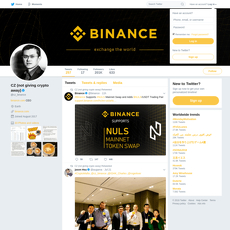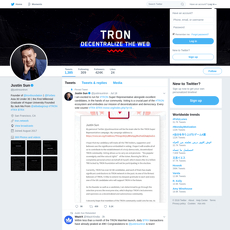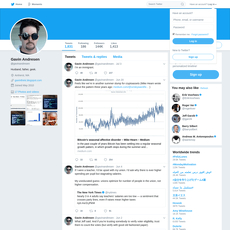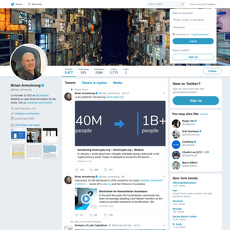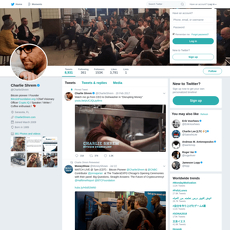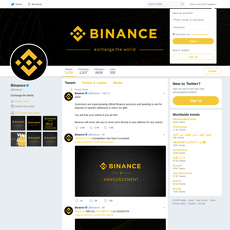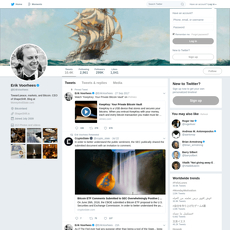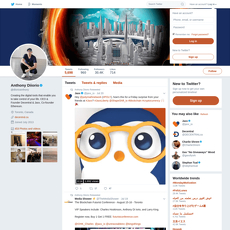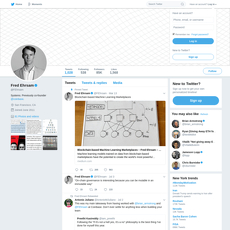Bryce “Muad'Dib” Weiner Review
Bryce “Muad'Dib” Weiner
twitter.com
Bryce “Muad'Dib” Weiner Twitter Review Guide: What to Track, Verify, and Ignore (With FAQ)
Ever scroll crypto Twitter and think, “Is this voice worth my time?” If you’ve seen Bryce “Muad'Dib” Weiner pop up in your feed, you’ve likely caught the strong takes, historical callbacks, and spicy debates. The real question is simple: does following him help your research, your trading, or your understanding of the space?
My goal here is to cut through the noise and set you up with a practical way to get value—from any loud voice on Crypto Twitter—without getting dragged into unproductive drama or low-quality signals.
It’s hard to know who’s legit, what’s true, and which claims are worth your attention
Crypto Twitter is a wild place. Takes move faster than facts. Reputations are tangled. Engagement is a currency. Meanwhile, you just want to make better decisions.
- Signal vs. spectacle: Strong opinions spread quickly; real research takes time. One MIT study found false news spreads “farther, faster, deeper, and more broadly” than the truth on Twitter—especially for political and financial content (Vosoughi et al., Science).
- Receipts are buried: Claims about old projects, forks, partnerships, or “I called it” moments get tossed around without links, tx hashes, or archived sources.
- Engagement traps: Outrage, sarcasm, and dunk threads rake in likes. That doesn’t mean there’s actionable information underneath.
- Time sink risk: Arguing in replies can burn hours you could spend checking on-chain data or reading code.
If you’re feeling that friction, you’re not alone. The fix is a repeatable way to evaluate voices like Bryce’s—fast.
Here’s how I’ll help you cut through the noise
I’ll show you a simple system to evaluate Bryce’s content (and any other influencer) without getting lost:
- Track: Log recurring topics and claims into a simple note (date, topic, claim, link).
- Verify: Use public sources—on-chain explorers like Etherscan, repositories on GitHub, snapshots on Wayback Machine—to confirm history and statements.
- Filter: Tag what’s actionable (data-backed, time-stamped) vs. what’s entertainment or speculation.
- Protect: Set rules to mute/ignore when threads turn purely performative or repetitive.
- Compare: Cross-check takes with a few trusted builders, analysts, or data dashboards before acting.
This keeps your focus on what actually helps: evidence, timelines, and patterns.
What this review covers (and what it doesn’t)
- What you’ll get: A fair look at Bryce’s public presence on Twitter/X, the themes he returns to, the style of debates, how to validate claims, and how to spot signal.
- What you won’t get: Financial advice, a character judgment, or cheerleading. The point is utility—for your research and your time.
For clarity, when I reference “verification,” I’m talking about concrete checks you can run yourself: repo history, contract addresses, tx hashes, team pages, archived announcements, and discussion threads from multiple communities.
Who this guide is for
- Retail traders who want to avoid chasing every hot take and focus on measurable edges.
- Builders who want to separate real technical insights from loud narratives.
- Researchers/analysts who need a fast workflow to confirm claims and map context.
- Crypto-curious readers who want to learn without getting pulled into never-ending drama.
“Strong opinions are fine. Strong opinions with receipts are useful.”
So, who is Bryce “Muad'Dib” Weiner, what’s the story behind the persona, and why do his takes stir up so much attention? In the next section, I’ll set the quick context so you know exactly what you’re looking at when his tweets hit your timeline.
Who is Bryce “Muad'Dib” Weiner? The quick context
I think of Bryce as one of those long-timer voices on crypto Twitter who shows up when narratives get loud and says, “Hold on—where are the receipts?” He’s been active across multiple cycles, he’s fast to jump into public debates, and he wears the “Muad'Dib” mantle like a statement: survive the sandstorm, remember the past, don’t fear the heat.
He doesn’t play the “brand-safe” game. If you’re looking for polished PR takes, you won’t find them. If you want someone who pushes back on hype and demands specifics—audits, vesting calendars, on-chain evidence—you’ll see that pattern in his replies and quote tweets.
“I must not fear. Fear is the mind-killer.” — Frank Herbert, Dune
That quote fits his whole presence. He tends to cut through fear-based marketing and calls out weak claims, even if it sparks a pile-on.
The “Muad'Dib” persona and style on Twitter
What I notice most is how he leans into the role of the contrarian memory keeper—the person who says, “We tried this in 2017/2020; here’s how it went.” The tone can be blunt, sarcastic, and occasionally combative, but there’s usually a thread running through it: test big claims with simple checks.
- Receipts over vibes: He’ll ask for the audit PDF, team page, or GitHub repo instead of taking a victory lap on promises.
- Quote-tweet sparring: He often challenges claims publicly rather than DMing quietly. Expect pushback in the open.
- Cycle memory: He references prior cycles—before/after major forks, popular ICO playbooks, L2 trust models—so newer followers get context, not just hot takes.
- “Show me the mechanism” energy: If a project uses technical jargon, he’ll press for the actual mechanism (consensus, sequencer trust, unlock schedule, funding source).
It’s a style that creates friction, which—love it or hate it—gets attention. Social platforms amplify confident, emotive language, and crypto is no exception. Research has shown that moral-emotional wording spreads faster on social media, which helps explain why strong stances draw engagement (Brady et al., 2017).
What he’s known for in crypto conversations
Across market cycles, he’s been part of ongoing conversations around altcoin narratives, market structure, and the way crypto history repeats itself with new branding. You’ll see him push for clarity on:
- Token mechanics: If a project hypes “audited,” he’ll ask for the auditor name and report link. If they tout “fair launch,” he’ll ask about premine, insider allocations, and vesting timelines.
- Market structure reality: He often points out how liquidity, market maker arrangements, and unlocks shape price action more than slogans do. For example, when token unlock dates trend, he’ll usually highlight the actual schedule and recent liquidity conditions rather than “number go up” hopium.
- L2 and bridge trust: He questions sequencer trust models, exit assumptions, and which parts are genuinely decentralized. Expect him to ask, “What fails if X party disappears?”
- Industry amnesia: When something “innovative” resurfaces, he’ll bring up the 2017 or 2021 version of the same idea and how it ended. That pattern-matching is where a lot of people find signal.
This approach matters because bold statements travel faster than true ones on social platforms. A well-known study found that false or unverified news often spreads quicker than true information on Twitter (Vosoughi, Roy, Aral, Science 2018). Voices that slow things down and ask for proof act as counterweights—useful if you’re trying to avoid narrative whiplash.
Why people follow him (and why some don’t)
- Why follow:
- Historical memory: He connects today’s hype to yesterday’s outcomes, which is priceless in a market with short attention spans.
- Receipts culture: He expects claims to come with sources—audits, on-chain links, team bios, GitHub activity, funding disclosures.
- Contrarian filters: When everyone’s euphoric, he points at risks. When everyone’s panicking, he looks for mechanics, not emotion.
- Why some bounce:
- Confrontational tone: The public call-outs and sarcasm aren’t for everyone.
- Zero patience for fluff: If you want cheerleading or gentle coaching, you won’t get it here.
- High-friction threads: Big debates can hijack your timeline; some prefer a calmer feed.
I’ll put it this way: if you like your influencers “brand-friendly,” he’s not that. If you prefer voices that kick the tires on claims before they roll downhill, you’ll probably pick up useful habits by watching how he argues.
Curious what actually shows up in your timeline if you hit “Follow”? Next, I’ll walk through the common topics, the cadence, how debates start (and end), and—most important—how I separate heat from signal so I don’t get dragged into noise. Want a simple way to tell which of his posts are worth your clicks?
What you’ll actually see on his feed
Open his X feed on any volatile day and you’ll get a stream that mixes market color, sharp contrarian punches, and the occasional nerdy builder rant. It’s not a quiet timeline. It’s fast, emotional, and often useful if you know how to sort the heat from the signal.
“Strong opinions are cheap; verified receipts are gold.”
If you’ve ever felt overwhelmed by crypto Twitter, you’re not alone. The trick is knowing what you’re looking at and how to respond in real time.
Common topics: markets, altcoins, industry drama, builder takes
- Markets: Expect comments on Bitcoin dominance, ETF flow narratives, funding rates, and “who’s trapped” after big moves. You’ll sometimes see quick reads on whether a pump was perps-driven or spot-led.
Sample pattern: “BTC up, alts bleeding? Watch DXY + DOM. If DOM breaks here, alt rotation might have legs.”
What I check: a real chart or data source TradingView, Dune, or exchange OI pages) before I let it steer my bias. - Altcoins: Mentions of small caps, rotation windows, memecoin seasonality, and unlock calendars. There’s often a call-out on token distribution fairness or liquidity traps.
Sample pattern: “FDV too high, float too thin, unlock next week—pass.”
What I check: token unlock pages, CoinGecko circulating/FDV, and contract holder concentration on Etherscan. - Industry drama: Spicy, yes. You’ll see critiques of VC deal flow, exchange listing games, alleged wash volumes, and influencer payout rumors.
Sample pattern: “Look at the vesting file vs. the announcement—they moved the goalposts.”
What I check: archived team docs, tokenomics PDFs, or governance forums that confirm the claim. - Builder takes: Threads on L1 vs L2 trade-offs, sequencer revenue, MEV, and token design. Occasionally argues for simple architectures over complex token games.
Sample pattern: “If the sequencer is the business, the token needs a real claim on it—or it’s a story, not a model.”
What I check: links to code, PRs, or protocol docs. If none are provided, I flag it as opinion until proven.
Posting cadence, tone, and engagement style
- Cadence: Bursty. Quiet for stretches, then rapid-fire during news, unlocks, or exchange incidents. Late-night threads are common around global market moves.
- Tone: Assertive and sarcastic, sometimes confrontational. The “Muad’Dib” persona leans into calling out sacred cows and poking at groupthink.
- Engagement: Heavy on quote-tweets to frame debates. Replies can escalate quickly, which is why I keep notifications on but never mirror a take without checking sources. If you ask substantive questions, you sometimes get receipts—if you ask tribal ones, you’ll get fire.
Notable threads: where debates start and how they end
- Typical spark: A contrarian read on a popular headline—“That chart is cherry-picked,” “Those volumes are rebates,” “This is marketing, not product.”
- Middle game: Screenshots, old quotes, archived links. You’ll often see historical context used as ammo. Good threads include data or code; weak ones lean on vibes.
- Endgame: Either a clear TL;DR summary or everyone gets blocked and moves on. I bookmark only the ones with sources, then compare against later outcomes.
- How I keep up:
- Use X Advanced Search to stitch timelines: from:bryceweiner min_faves:50 to surface higher-signal posts.
- Save long posts with Thread Reader to re-check claims later.
- Look for concrete anchors: Etherscan links, governance proposals, GitHub commits, or Dune dashboards. No anchors? I tag it as “entertainment” until proven.
How to separate hot takes from actionable insights
I use a fast filter. It keeps me from getting pulled into arguments that don’t make me money or make me smarter.
- Actionable has:
- A primary source (on-chain tx, SEC/press filing, GitHub PR, or verifiable chart).
- A time horizon (“this week,” “pre-unlock,” “post-merge,” not “soon”).
- Clear risks and what would invalidate the idea (“if funding flips, thesis is dead”).
- Hot take hallmarks:
- No links, just strong language.
- Cherry-picked visuals or cropped screenshots without context.
- Shifting goalposts after pushback or mass-deleting context.
- Cross-check hack (1–2 minutes):
- Search the contract on Etherscan and click “Holders” for top 20 concentration.
- Open the project’s repo and sort by recent commits; is there real development or just docs updates?
- Check unlock/vesting on a public tracker and compare to the claim.
There’s a reason this matters. An MIT study in 2018 found that false news spreads faster than true news on Twitter. In crypto, confidence can be confused for accuracy—and algorithms reward heat. That’s why I only upgrade a claim from “interesting” to “useful” once I’ve tied it to receipts.
So, when a thread on his feed hits your screen with big energy, ask yourself: Where’s the proof, who benefits, and what would make this wrong? If you can’t answer in a minute, it’s not yet tradeable intelligence—it’s theater.
Want the exact toolkit I use to check claims—on-chain, on GitHub, and across community archives—in under five minutes? Keep reading. In the next section, I’ll show you the simple verification workflow I run every single time. Ready to see how I pull the receipts fast?
Track record, receipts, and how to verify claims
I love strong opinions, but I love receipts more. When Bryce “Muad'Dib” Weiner makes a claim—about a project he touched, a chain he forked, or a market call—I don’t argue in replies. I go hunting for evidence. It’s faster, calmer, and a lot more useful.
“Extraordinary claims require extraordinary evidence.” — Carl Sagan
Here’s exactly how I check what’s real, what’s outdated, and what’s pure theater—plus the tools and queries you can copy-paste right now.
Projects and mentions tied to his name: how I check them
First, I build a list of everything he’s publicly connected himself to. I want names, repos, contracts, and dates. I don’t rely on memory or community lore—I pull it from his own feed and archive it.
- Surface claims with X search:
- from:BryceWeiner launch
- from:BryceWeiner whitepaper
- from:BryceWeiner github
- from:BryceWeiner mainnet OR testnet
- from:BryceWeiner token OR erc20 OR fork
- Archive everything immediately: when I find a relevant tweet, I save it to archive.today and the Wayback Machine. Deleted or edited posts are common; archives keep the timeline clean.
- Map each mention to artifacts: for every project name he cites, I try to pin:
- Official website (live and archived)
- GitHub/Bitbucket/GitLab repo
- Smart contract(s) or node repo
- Announcement blog post or forum thread
- Explorer link (if it’s an L1/L2 or token)
- Cross-check third-party chatter:
- Reddit search: “Bryce Weiner” on Reddit
- Bitcointalk via web search: site:bitcointalk.org “Bryce Weiner”
- Old Medium/Substack posts via Wayback: look for team lists, credits, or changelogs
Example workflow: If he says, “I helped ship Project X in 2017,” I grab the tweet, archive it, then look for the 2017 repo tags, a contemporaneous announcement, and any explorer evidence tying the deployer to a handle he used. No artifacts? I mark it “unverified” and move on.
Why this matters: social media moves crypto prices. Studies and market reports consistently show that influential tweets can move short-term returns and spark speculative flows. That’s exactly why verification protects you from your own FOMO.
- Example resource: Blockchain Research Lab on how tweets influence crypto
- Example resource: Chainalysis Crypto Crime Report (scam patterns and hype mechanics)
Using on-chain data and explorer links to validate statements
On-chain receipts beat narratives. If a claim involves a launch, a migration, a burn, or a big transfer, I try to tie it to a wallet, contract, or transaction trail.
- ERC-20/721/1155 tokens (Ethereum):
- Find the token on Etherscan. Open the contract, click “Contract Creator” to see the deployer address and tx date.
- Check “Read Contract” for owner/admin roles, and “Write Contract” history for transfers of ownership.
- Open “Analytics” → “Token Distribution” to see if early holders match wallets publicly associated with the team.
- Look for links between the deployer and public identities (ENS on ENS, GitHub in commit metadata, or addresses posted in old docs).
- Other EVM chains: same playbook on BscScan, PolygonScan, Arbiscan, Optimistic Etherscan.
- Solana: use Solscan or Solana Explorer to inspect program deployers, upgrade authorities, and mint authorities.
- Bitcoin-like chains (UTXO): look for genesis block messages, early coinbase outputs, and forum announcements that timestamp a launch. If it’s a fork, the initial repo often contains hardcoded genesis parameters you can match to the running chain.
- Migrations and bridges: if there’s a claim of “we migrated tokens,” verify the burn on the source chain and the mint on the destination chain, ideally via official bridge contracts or snapshot-based distributions published at the time.
Tip: if a thread says “we deployed X,” but the deployer address belongs to a known third-party factory, check “Internal Txns” and the source code comments to see who actually clicked deploy vs. who wrote and verified the code.
GitHub, team pages, and timelines: the fast way to confirm history
Code and changelogs tell cleaner stories than replies. I don’t need to decide who’s loudest; I check who committed what, and when.
- Start with the repo: open “Insights” → “Contributors” on GitHub to see if his handle appears. Then switch to “Commits” and “Blame” for critical files (consensus params, token contracts, migrations).
- Signed commits and emails: check if commits are GPG-signed and whether the email matches a known identity. Note: author emails are easy to spoof; consistency over time matters more than one-off commits.
- Tags and releases: match release tags to public announcements you archived. If a tweet claims a February launch but the first tagged release is April, you’ve got a timeline mismatch.
- Fork lineage: look at the network graph to see if the repo is a fork. If so, inspect what changed: params only (quick fork) or substantive code (real engineering)?
- Wayback for team pages: if a project site credited him as a contributor, confirm with the Wayback Machine around the alleged timeframe. Compare multiple snapshots to catch retroactive edits.
- Issues and PRs: sometimes influence shows up in issues, not commits. Search for his handle in issues/PRs for design decisions, audits requested, or release blockers.
Fast signals I trust: dated release notes, consistent commit history across months, and third-party mirrors (e.g., package registries, Docker Hub tags, PyPI/NPM versions) that align with the public story.
Community sentiment scan: forums, archives, and snapshots
Sentiment is not truth, but it explains friction. I scan reactions to understand whether a claim is contested, controversial, or widely accepted. Then I chase the primary sources.
- Social and forums:
- Reddit keyword search to surface long-form discussions
- Web search on Bitcointalk results: site:bitcointalk.org “Bryce Weiner”
- X advanced search around specific dates, then archive posts with archive.today
- Media triangulation: check if independent outlets reported the same claim at the time, not years later. I prefer pieces that link to repos, commits, or tx hashes.
- Snapshot and governance: if the claim involves DAO decisions or grants, verify votes on Snapshot and cross-check the voting power of addresses involved.
- Price and volume context: pull historical price/volume around the announcement date using CoinGecko or CryptoCompare. Big spikes with thin liquidity often amplify narratives; that doesn’t equal proof.
What I don’t overweight: personal feuds, dunk threads, and ratio wars. They’re entertaining, but they’re also noise. I keep circling back to code, contracts, and timestamps.
Here’s the emotional check I use before I act on any high-heat thread that mentions Bryce: “Am I reacting to the tone, or the evidence?” If I can’t answer with a link, a hash, or a commit, I park it. Next up, I’ll show you how I follow controversial voices without getting wrecked—what rules I set, the red flags that end the conversation, and how I build a feed that keeps me sharp rather than salty. Ready for the part that actually protects your money?
Safety first: how I follow controversial voices without getting wrecked
Hot takes move fast. Money moves faster. The only way I stay sane (and solvent) when scrolling strong opinions is by putting guardrails in place before the hype kicks in.
“Strong opinions are free; losses are paid in cash.”
Here’s the exact “risk firewall” I use when following loud, polarizing feeds so I can learn without becoming exit liquidity.
My rules for consuming influencer content
- Delay is discipline. I use a 24-hour cool-off rule on any fresh “alpha” unless it’s already on my pre-planned watchlist with defined triggers. Impulse is where most PnLs go to die.
- Evidence, or it didn’t happen. If a post makes a claim (partnership, new chain, tokenomics change), I look for a primary source:
- Official blog or press page
- Company account confirmation on X
- On-chain event that matches the claim (contract deploy, governance vote, new multisig)
- Never trade a ticker; trade the contract. I copy the contract address from a trusted source (project site, verified explorer page) and check it on Etherscan or the relevant explorer. No address, no trade.
- Basic token safety checks, every time:
- Ownership renounced or multisig controlled? Suspicious mint functions?
- Top 10 holders concentration and unlock schedule
- Buy/sell tax and trading pause flags
- Liquidity: size, lock status, and pair info on Dexscreener or GeckoTerminal
- Size like you’re wrong first. New narrative? I cap first entries at 0.5–2% of liquid portfolio, with a hard invalidation level. If the thesis is right, I can always add later; if it’s wrong, I live to fight.
- Archive everything. I screenshot and save links to Wayback Machine or archive.today. Receipts beat regrets.
- Lists over algorithm. I read via X Lists to reduce echo chambers. I keep a “Data,” “Builders,” “Skeptics,” and “News” list. The goal is multiple lenses, not just louder ones.
- Assume hype decays fast. A 2019 academic study (Hamrick et al.) documented how coordinated pump groups drive short-lived spikes—most gains evaporate within hours. I treat sudden Twitter-fueled runs as fleeting unless supported by verifiable fundamentals.
- Expect sentiment whiplash. Research has shown single tweets can move crypto markets intraday (for example, Lennart Ante’s 2021 work on high-profile accounts). Translation: don’t let one post override your plan.
Real sample: A thread hints at a “Fortune 100 partnership” for a micro-cap. I search the company newsroom—nothing. I check the project’s official accounts—silence. I wait. Price spikes 28% on the rumor, then round-trips by evening when no press release drops. My cool-off rule saves me from providing someone else’s exit.
Red flags I watch for (and what I do when I see them)
- No contract, just a ticker. If the symbol is pushed without a verifiable address from an official channel, I ignore it. Period.
- “Partnership” without a primary source. If there’s no press release, no co-announcement, or no on-chain change, I treat it as marketing, not news. I’ll ask for sources once; if it’s hand-waving, I mute the thread.
- Urgency language. “Only hours left,” “won’t say this again,” “delete soon.” Manufactured FOMO is my cue to slow down.
- Private group funnel. Posts pushing me to Telegram/Discord for the “real alpha” often lead to fee groups or coordinated pumps. I stay out.
- Undisclosed incentives. Affiliate links or token allocations without a clear disclosure = I assume bias. If disclosure patterns are consistently vague, I unfollow.
- Selective memory. If bad calls vanish while victory laps remain, I start archiving. A pattern of post-hoc edits or deletions gets a soft block.
- Sketchy token mechanics. High taxes, trading pause functions, mint authority in a single wallet, or liquidity controlled by a non-multisig deployer—these are instant passes.
My response playbook: unroll the thread, ask for a source once, archive, step back 24 hours, and look for independent confirmation from data accounts or official teams. If the tone turns hostile or cultish, I cut the noise with mutes and RT-off.
Building a balanced feed: who to follow alongside Bryce
One strong voice is useful. A strong mix is safer. I balance opinionated feeds with data-first, builder, and skeptical perspectives.
- Data and on-chain: @glassnode, @santimentfeed, @coinmetrics, @KaikoData
- Market structure and derivatives: @skewdotcom, @CoinGlassData
- On-chain sleuths: @zachxbt and similar researchers who post wallet evidence and timelines
- Builders and researchers: protocol engineers, security auditors, and governance contributors who share RFCs, PRs, and code diffs
- News and aggregation:CryptoPanic, CoinDesk, and The Block for cross-checking headlines
Pro tip: use X Lists named “Data,” “Builders,” “Skeptics,” and “News.” Read each list separately. If an opinion sparks action, confirm with at least one data source and one official source from those lists before you move.
Reminder: opinions aren’t financial advice—make your own calls
I treat every post—mine included—as input, not instruction. Before I touch a button, I force a quick checklist:
- Thesis in two lines. If I can’t explain why I’d buy and what would prove me wrong, I pass.
- Defined invalidation. Where does this trade die? Hard stop or time stop.
- Sizing rules. Speculative positions stay small (0.5–2%). Winners earn size; opinions don’t.
- Independent confirmation. One opinion + at least one data point + one official source.
- Receipts. I log the source post, the reasoning, and the outcome. Bias shrinks when your own history is in writing.
If you’ve ever felt that knot in your stomach right after pressing “buy” on a loud thread, you’re not alone. The fix isn’t muting every strong voice—it’s building a system that keeps your money safe while your curiosity stays wide open.
Want the exact 60-second toolkit I use to verify claims—and quick answers to questions like “What’s the most legit Bitcoin app?” and “Is BitScreener actually legit?” Keep reading; I’ll spell it out next.
FAQ: quick answers people keep asking
What is the most legit Bitcoin app?
There isn’t a single “most legit” app for everyone. Pick by job-to-be-done. Here’s the simple playbook I use with friends and family so they don’t get burned:
- Buying (regulated, fiat on-ramps): Coinbase, Kraken, Cash App. They’re long-running, widely regulated, and make bank transfers easy. Just remember: custodial ≠ your keys. Buy there, then move to self-custody.
- Self-custody on mobile (beginners to intermediate): Phoenix (Lightning; great for payments), Muun (clean UX; handles on-chain and Lightning), Blockstream Green (2FA-powered spending limits). All are well-known brands with strong track records. Start small and practice a restore with a tiny amount before you trust them with real money.
- Desktop + hardware (long-term savings): Sparrow Wallet with a hardware wallet (Trezor, Ledger, Coldcard, Blockstream Jade). You get PSBT support, multisig if you want it, and serious control over fees and privacy.
- Payments: Phoenix or Breez for Lightning spending; Cash App or Strike for simple person-to-person payments in supported regions.
Security tips that actually move the needle: turn on 2FA (ideally a TOTP app like Aegis/Authenticator). Google’s 2019 security study showed basic 2FA blocks the vast majority of account hijacks—up to 100% of automated bot attacks and 96% of bulk phishing attempts. Source: Google Security Blog, 2019.
Sample beginner setup I’ve used that works: buy small amounts on Cash App, auto-withdraw to Muun, and when your stack grows, graduate to Sparrow + a hardware wallet. You get an easy start without skipping the self-custody learning curve.
Is BitScreener legit?
It’s a long-running market data and news app—not an exchange, not a wallet. That’s key: it doesn’t hold your funds. I treat BitScreener as a watchlist/alerts/news companion, not a place to store value or connect sensitive API keys.
- Green flags: public app-store presence for years, straightforward feature set (prices, charts, news, alerts), and no seed-phrase requests. Market-data apps should never ask for private keys or seeds.
- Neutral-to-yellow flags (standard for data apps): ad/affiliate links, optional sign-in for syncing, and analytics trackers. Read the privacy policy and limit data sharing. If they offer exchange API linking, use read-only keys and IP-restrict them.
Bottom line: as a price/news screen, it’s fine. I wouldn’t feed it secrets. Keep it as a data layer in your stack, not a custody layer.
How do I evaluate any crypto influencer fast?
I run this 60-second triage. If any step smells off, I throttle attention or mute:
- Identity and history: google “[name] + project + controversy,” check old tweets with X’s advanced search (by date), and look for consistent themes vs. flip-flops.
- Incentives: do they disclose bags, sponsorships, or early allocations? A simple “I hold” or “sponsored” line matters.
- Receipts: when they make a claim, do they back it with on-chain links, GitHub commits, docs, or filings? No receipts = low signal.
- Hit rate: sample 3–5 old calls and see how they aged. Everyone misses sometimes; you’re looking for honesty and post-mortems.
- Language red flags: “guaranteed,” “risk-free,” relentless price targets, and chronic timeline bait. Serious builders rarely talk like that.
- Link hygiene: hover on links, use urlscan.io or VirusTotal for unknown domains, and avoid connecting wallets off random threads.
- Community check: scan replies and quote tweets from known builders/analysts. Are they respected by credible people or just farmed by engagement pods?
- On-chain check (if relevant): when they tout a token, peek at token distribution and team wallets on Etherscan/Solscan. If the team wallet just sent a chunk to a DEX, that’s a sign to pause.
- Time horizon fit: if you’re long-term, don’t follow a scalper for macro; if you’re intraday, don’t follow a historian for entries.
- Behavior under pressure: the best tell. During drawdowns, do they go silent, rage, or calmly reassess with data?
Why so strict? Scams remain the biggest threat to retail. Chainalysis’s Crypto Crime research shows scams and fraud are consistently the most damaging category by victim count, even when total illicit volume fluctuates with markets. The FTC has also reported over $1B lost to crypto scams in consumer complaints since 2021—this is not a small problem.
What tools do you use to verify claims and news?
I keep a compact toolbelt so I can verify in minutes, not hours:
- On-chain reality check:
- Bitcoin: mempool.space to confirm transactions, fees, and unconfirmed backlogs.
- Ethereum: Etherscan (holders, token approvals, contract source, internal txs). Use Etherscan’s Token Approval Checker if a “wallet drained” story mentions bad approvals.
- Solana: Solscan or SolanaFM for holders and program interactions.
- Aggregate dashboards: Dune for community dashboards; Token Terminal for fundamentals; Dexscreener for new pairs and liquidity.
- Market structure and sentiment:
- TradingView for clean charts, alarms, and multi-exchange data.
- CoinGlass for funding, open interest, liquidation maps, and heatmaps.
- Code, teams, timelines:
- GitHub activity (stars mean little; look for commits, issues, and contributors).
- Company/legal: OpenCorporates, SEC EDGAR, and local registries (e.g., UK Companies House) to confirm entities and executives.
- Project memory: Wayback Machine and archive.ph for deleted pages and shifting roadmaps.
- News and claims:
- Cross-check headlines across multiple outlets before reacting. I monitor CoinDesk, The Block, and official company blogs. If only one outlet has it, I wait.
- For exploits/approvals: search the contract on Etherscan and check the token’s “Transfers” + “Holders.” Actual exploits leave footprints.
- Security and links:
- VirusTotal or urlscan.io for suspicious URLs/attachments.
- Browser hygiene: use a burner browser profile and a separate wallet for testing dapps you don’t fully trust.
Rule of thumb: if a claim can’t survive Etherscan, a couple of credible news checks, and one archive lookup, it doesn’t deserve your capital or your time.
One more practical note: always switch to read-only exchange API keys when testing third-party trackers, and set withdrawal whitelists/IP restrictions where possible. It’s the boring stuff that saves accounts.
Extra resources
- Google Security Blog (2019) on 2FA effectiveness: New research: How effective is basic account hygiene at preventing hijacking
- Chainalysis Crypto Crime research: chainalysis.com
- FTC consumer warnings on crypto scams: FTC Data Spotlight: Cryptocurrency scam losses
- Bitcoin wallet best practices (community docs): bitcoiner.guide/wallets
Want my filtered verdict on whether Bryce is worth your follow—and the exact alert setup and checklist I use so I never get blindsided by a hot take? Keep going; I’ll lay it all out next.
My verdict on following Bryce “Muad'Dib” Weiner—and how to get value from it
I keep Bryce on a tight, curated list and treat his feed like a signal scanner, not a buy/sell feed. The upside: he spots narrative shifts early, he’s blunt about industry dynamics, and he remembers context most people forget. The downside: strong opinions, sharp conflicts, and zero hand-holding. If you use structure—alerts, verification, and note-taking—you can extract real value without getting caught in the crossfire.
Who should follow him (and who should skip)
- Good fit: builders and researchers who want fast takes on market structure, alt narratives, and industry history; traders who like sentiment and narrative tracking; journalists and analysts who need a BS detector to stress-test assumptions.
- Maybe: long-term investors who want perspective but don’t want daily noise—put him on a list and skim weekly.
- Skip: absolute beginners who haven’t built a verification habit; anyone who’s easily swayed by confident claims; people who hate confrontational debate.
Bottom line: follow for perspective, not signals. You’ll get sharp context and early narrative pings—as long as you verify before you act.
Action plan: set alerts, build a verification checklist, and keep receipts
- Set up a controlled feed
- Create an X/Twitter List called “Critical Voices.” Add Bryce there. Read the list—not your home feed—to avoid algorithmic dogpiles.
- Use TweetDeck/Deck mode: add columns for from:@bryceweiner (no replies) and keyword filters like from:@bryceweiner “thread” OR “PSA” OR “disclosure”.
- Turn on the bell only for the List, not your entire feed, so you don’t get spammed by replies.
- Verification checklist (copy/paste this into your notes)
- Is this a technical claim? Check repos and diffs on GitHub. Compare codebases and licenses. Use GitHub “compare” or diffoscope for forensic diffs when repos look forked.
- Is this an on-chain claim? Pull TXs and holdings on Etherscan/Solscan. Save links with TXIDs. Cross-check on-chain labels via DeBank or a second explorer.
- Is this a history/timeline claim? Use Wayback Machine and archive.today to confirm old team pages, announcements, and dates.
- Is this a corporate/entity claim? Search OpenCorporates, WHOIS, and LinkedIn for team consistency.
- Is this market commentary? Log the timestamp, instrument, and price. Revisit in 7/30/90 days before judging “accuracy.”
- Keep receipts (protect yourself and your research)
- Archive key threads with timestamps using Wayback or archive.today. Add the archive link to your notes.
- Screenshot with visible time and URL. Store in a “Claims Log” folder or a Notion/Obsidian page.
- When a claim references a contract or wallet, save both the explorer link and CSV export if available.
- Cross-check sentiment and attention
- Compare hot takes with funding rates and OI to avoid crowd-chasing. Quick tools: Coinalyze, Laevitas, or your exchange’s futures dashboard.
- Check attention proxies like Google Trends and tweet volume. Academic work shows investor attention often leads short-term crypto moves (see Liu & Tsyvinski, Journal of Finance 2021), but it can whipsaw you if you chase late.
- For a sanity test on Twitter-driven claims, remember multiple studies find Twitter sentiment can align with short-term volatility and returns (e.g., Kraaijeveld & De Smedt 2020). Treat it as a timing input, not a thesis.
- Behavioral guardrails
- Never execute on first exposure. If a post triggers FOMO, wait one full trading session. Re-check liquidity and slippage.
- Size any “influencer-sourced” idea tiny (0.5–1% starter). Expand only after independent validation.
- Mute pile-on threads. Read, log, move on. Don’t get sucked into drama—time is your edge.
- Use a personal hit-rate sheet. Track claims you acted on and outcomes vs. a benchmark. If your PnL or stress goes the wrong way, adjust or unfollow.
- Who to pair alongside
- Balance with data-first accounts (on-chain analytics, market structure, security researchers) and at least one skeptic who consistently posts receipts.
- Keep 2–3 “antidote” sources you trust. If a claim can’t survive those checks, it doesn’t make your watchlist.
Final take
I keep Bryce in my rotation for perspective, not for trades. He’s useful for detecting narratives early, pressure-testing industry myths, and remembering how we got here. The value comes when I pair that with my own verification routine and a calm head. Follow if you’re ready to check everything and treat his feed as one node in a wider research network. If you want quiet, skip—or park him on a list and scan when you’re in research mode.
CryptoLinks.com does not endorse, promote, or associate with Twitter accounts that offer or imply unrealistic returns through potentially unethical practices. Our mission remains to guide the community toward safe, informed, and ethical participation in the cryptocurrency space. We urge our readers and the wider crypto community to remain vigilant, to conduct thorough research, and to always consider the broader implications of their investment choices.


